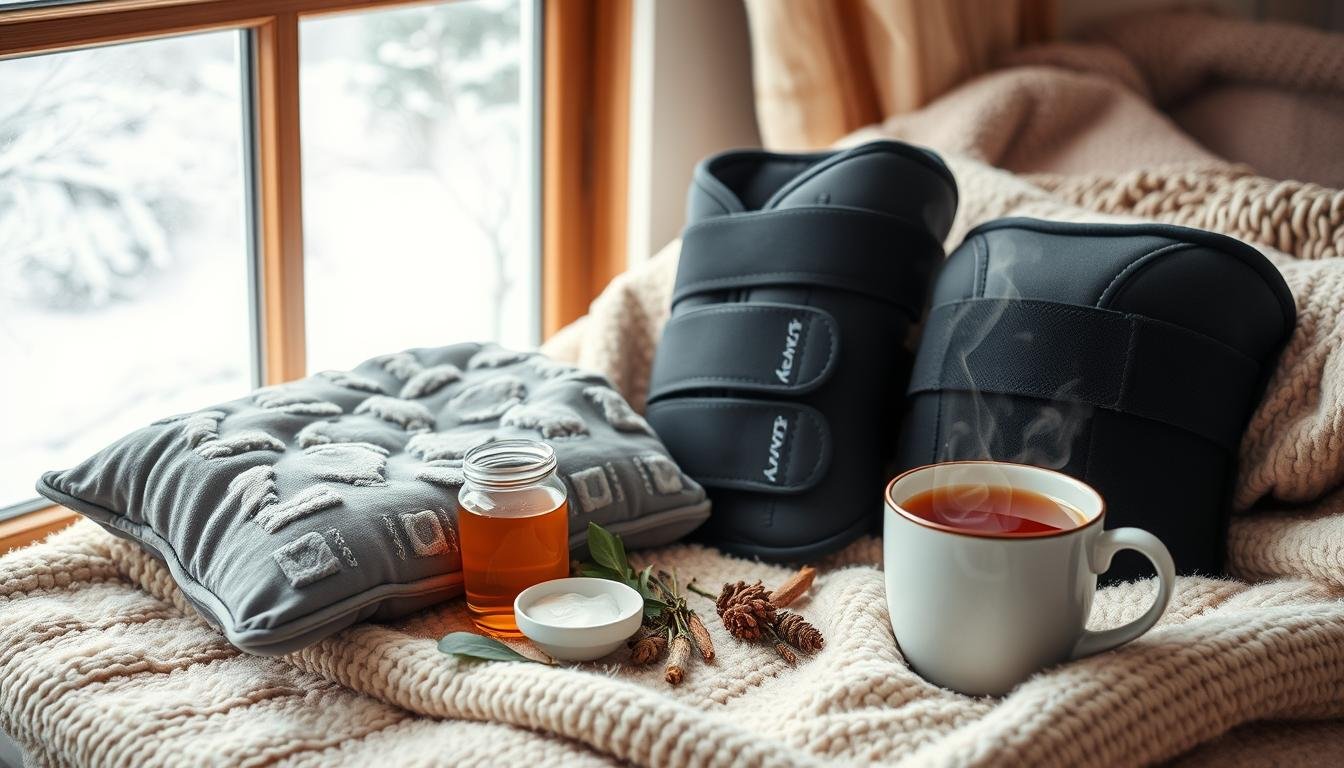Did you know 65% of people with knee osteoarthritis feel worse in winter? Cold weather makes our joints hurt more. This is because our knees get more sensitive when it’s cold.
This can really hurt our daily life. In this guide, we’ll look at why knee pain gets worse in winter. We’ll talk about how cold weather and less activity can make our knees hurt more.
We’ll also share ways to make knee pain better during the cold months. Understanding why it happens is key. Then, we can find ways to feel better.

Key Takeaways
- Barometric pressure changes, thickening of synovial fluid, and reduced blood flow to extremities are potential factors contributing to increased knee pain in winter.
- Cold weather can lead to muscle tightening, reduced flexibility, and changes in mood and lifestyle that may exacerbate knee pain.
- Understanding the science behind winter knee pain and implementing coping strategies can help manage the discomfort effectively.
- Proper winter clothing, maintaining physical activity, and exploring indoor exercise options are essential prevention strategies.
- Seeking professional medical help may be necessary for severe or persistent knee pain during the winter months.
Understanding the Science Behind Winter Joint Pain
When winter comes, many people with joint problems like arthritis feel more pain. This isn’t just in their heads. It’s because of real changes in our bodies when it gets cold.
Impact of Barometric Pressure Changes
Changes in barometric pressure are a big reason for winter joint pain. When it gets colder, the air pressure goes down. This makes the tissues around our joints swell. This swelling puts more pressure on our joints, making them stiffer, more inflamed, and painful.
Role of Synovial Fluid in Cold Weather
Synovial fluid is important for our joints. It cushions and lubricates them. But in the cold, this fluid gets thicker and less effective. This means our joints get more stressed and hurt more.
Blood Flow Changes During Winter
Our bodies also change in the cold. When it’s cold, our blood flow shifts. It goes to our vital organs instead of our joints. This means our joints get less blood, leading to stiffness, inflammation, and pain.
So, when we put all these things together – changing air pressure, thick synovial fluid, and less blood flow – we get a lot of joint pain and stiffness in the winter.
“Understanding the science behind winter joint pain is the first step in finding effective ways to manage and alleviate this common issue.”
The Connection Between Knee Pain In Winter and Weather Changes
Weather changes and knee pain are linked in complex ways. When it gets colder, our body reacts in ways that make joint pain worse. Cold weather makes the soft tissues around the knee tighten, making it harder to move and causing more tension.
Also, changes in air pressure can make tendons expand and contract. This makes knee pain feel worse.
People with worn-out cartilage feel more pain in their knees when it’s cold. This is because the cold weather exposes sensitive nerves. All these factors make knee pain worse in winter.
Research shows that quick changes in weather can hurt joint pain. Cold weather slows down blood flow, leading to muscle spasms and stiffness. It also makes the fluid in joints thicker, making them stiffer and more painful.
Strategies for Alleviating Knee Pain in Winter
There are ways to make knee pain better in the cold:
- Wearing a compression sleeve or thermal leggings on the knee can provide warmth and stability to the joint.
- Doing a dynamic warm-up before activities can help loosen up the joints and improve movement.
- Low-impact exercises like swimming or cycling can strengthen the muscles around the knees without making the pain worse.
- Keeping a healthy weight can reduce the strain on the knees and help with cold weather.
- Applying heat to the knee can help loosen it up and ease the pain.
- Using over-the-counter anti-inflammatory drugs can help reduce swelling and pain.
- Getting help from a physical therapist or orthopedic specialist can offer personalized treatment plans.
Understanding how weather affects knee pain and using these strategies can help manage knee pain in winter. This way, people can stay active and keep their joints healthy.
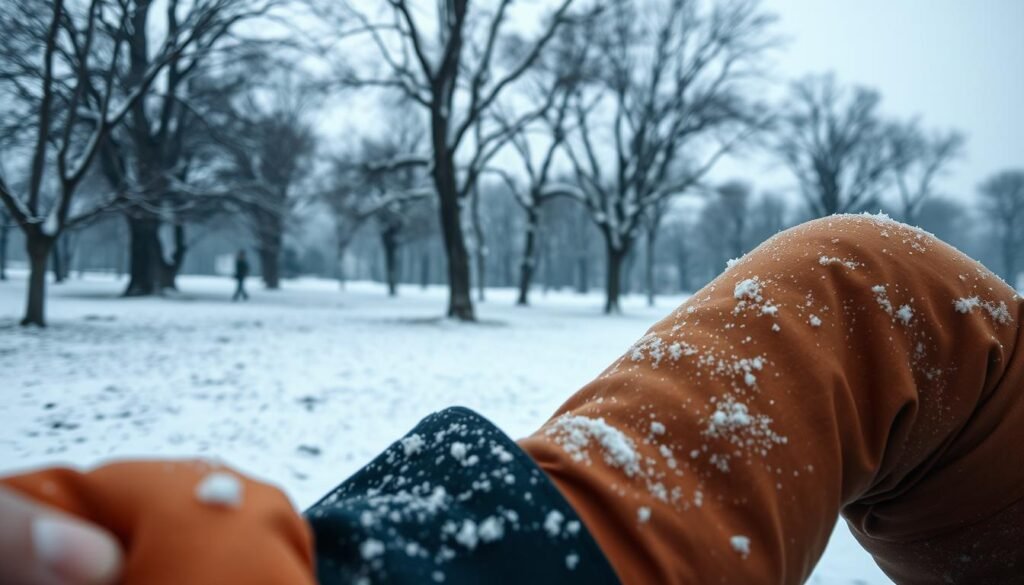
| Cause | Impact |
|---|---|
| Decreased Temperatures | Constriction of soft tissues around the knee, reducing flexibility and increasing tension |
| Fluctuations in Barometric Pressure | Tendons expand and contract, heightening pain sensitivity |
| Thinned Cartilage | Exposure of sensitive nerve endings, leading to increased discomfort |
Common Triggers for Winter Joint Discomfort
When it gets colder and the air dries out, many people feel more joint pain. It’s important to know why this happens. This way, we can find ways to feel better.
Temperature Fluctuations
Changes in temperature are a big reason for winter joint pain. When it’s cold, our joints get bigger and smaller. This can hurt and make moving stiff.
This problem is worse for people with arthritis. Simple tasks can become hard to do.
Humidity Levels
The cold, dry air of winter hurts our joints too. Low humidity damages the bones and cartilage. This leads to more pain and swelling.
This mix of cold and dry air makes joint pain worse.
Physical Activity Changes
Being less active in the cold also causes joint pain. We move less when it’s cold. Our joints get stiff and lose their flexibility.
This makes joint problems worse. It’s harder to keep our joints healthy.
Knowing why we get joint pain in winter helps us fight it. We can stay active and keep our joints moving. This keeps us feeling good all year.
How Cold Weather Affects Arthritis and Joint Health
For those with cold weather arthritis, winter can be tough. The cold, changing air pressure, and humidity can hurt joint health and make arthritis worse.
A 2019 British study with over 2,600 people found a link between cold weather and joint pain. It showed that humidity, air pressure, and wind speed affect joint pain. A 2015 study also found that humidity and temperature impact joint pain, especially in cold weather.
The cold makes joints work harder. The synovial fluid in joints gets thicker, making it less effective. Cold also makes inflamed joints more sensitive. This, along with less exercise in winter, can make arthritis symptoms worse.
“A 2007 study of 200 people with knee OA found that pain increased with every 10-degree drop in temperature.”
Cold weather affects more than just knee pain. It can lead to more flare-ups in rheumatoid arthritis and gout attacks.
While not all studies agree, many people with joint pain feel worse in cold weather. Wearing warm clothes and exercising indoors can help manage cold weather arthritis and keep joint health up during winter.
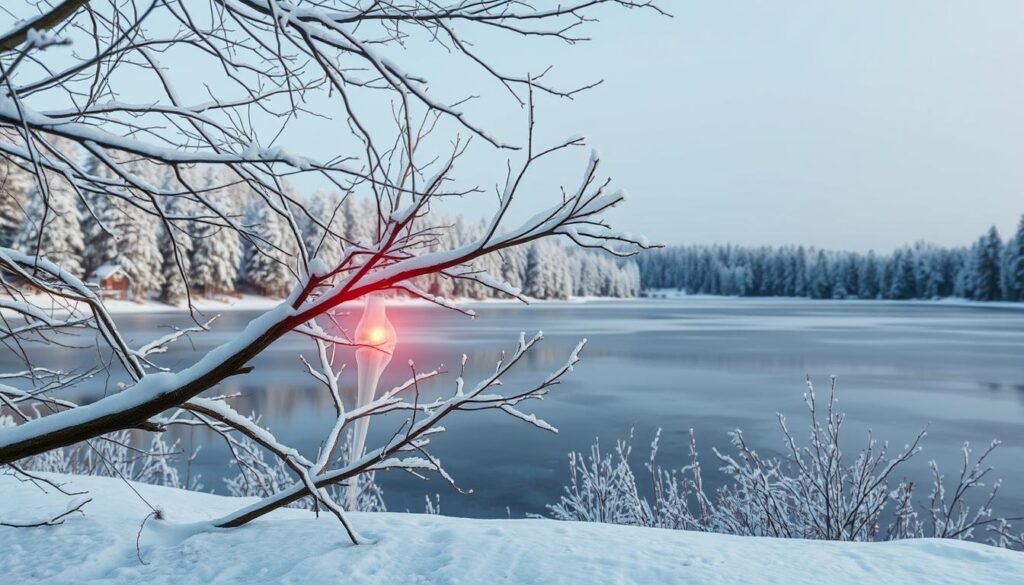
Prevention Strategies for Winter Knee Pain
When winter comes, we need to act fast to avoid knee pain. Simple steps can keep our knees safe and comfy all winter.
Proper Winter Clothing
Wearing the right clothes is key. Use warm, moisture-wicking fabrics like thermal leggings or knee-high socks. Add a warm coat, gloves, and a hat to stay warm and keep blood flowing.
Maintaining Physical Activity
It’s easy to want to stay inside, but moving is important. Try low-impact activities like walking, swimming, or cycling. These keep knees flexible and muscles strong. Don’t forget to stretch before and after to avoid stiffness.
Indoor Exercise Options
Indoor activities are great when it’s too cold outside. Yoga, Pilates, or a stationary bike are good choices. They keep joints moving and the body active in a cozy space.
By using these strategies, we can fight winter knee pain. Our joints will stay healthy and comfy all winter.
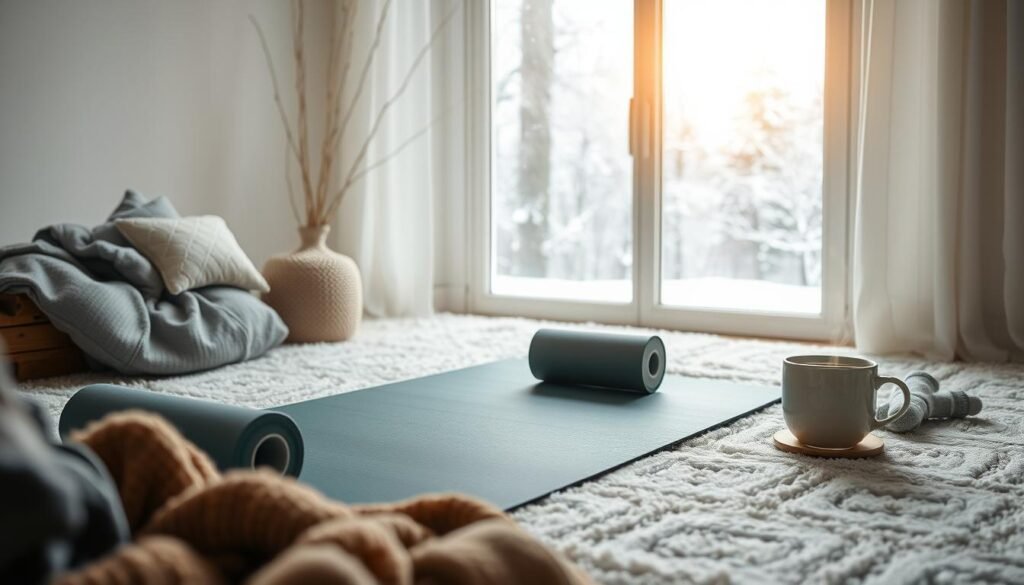
“Prioritizing healthy eating, staying active, and staying warm are crucial prevention strategies for managing winter knee pain.”
Effective Treatment Options for Cold Weather Joint Pain
When winter comes, many people feel more knee and joint pain. Luckily, there are many ways to help with this. Let’s look at some top ways to ease joint pain in the cold.
Heat therapy is a big help for joint pain in winter. Using warm compresses or taking a warm bath can help. It makes blood flow better and makes muscles less stiff.
Anti-inflammatory medicines like ibuprofen or naproxen can also help. But, always talk to a doctor before taking new medicines. This is especially true if you have health issues like stomach problems or kidney issues.
Some people use natural remedies to fight joint pain. Turmeric capsules, for example, have curcumin, which is good for reducing inflammation. Taking these can be a good, medicine-free way to handle joint pain in the cold.
Physical therapy is also very helpful for joint pain. A physical therapist can help you get stronger and more flexible. They can also teach you ways to manage pain that fit your needs. This is especially good for people with arthritis.
| Treatment Option | Description |
|---|---|
| Heat Therapy | Applying warm compresses or taking warm baths to boost circulation and loosen stiff muscles |
| Anti-Inflammatory Medications | Over-the-counter options like ibuprofen or naproxen to reduce swelling and pain |
| Natural Remedies | Turmeric capsules containing the anti-inflammatory compound curcumin |
| Physical Therapy | Working with a professional to build strength, improve flexibility, and learn effective pain management techniques |
Always talk to a doctor before trying new treatments. This makes sure they’re right for you and your health.
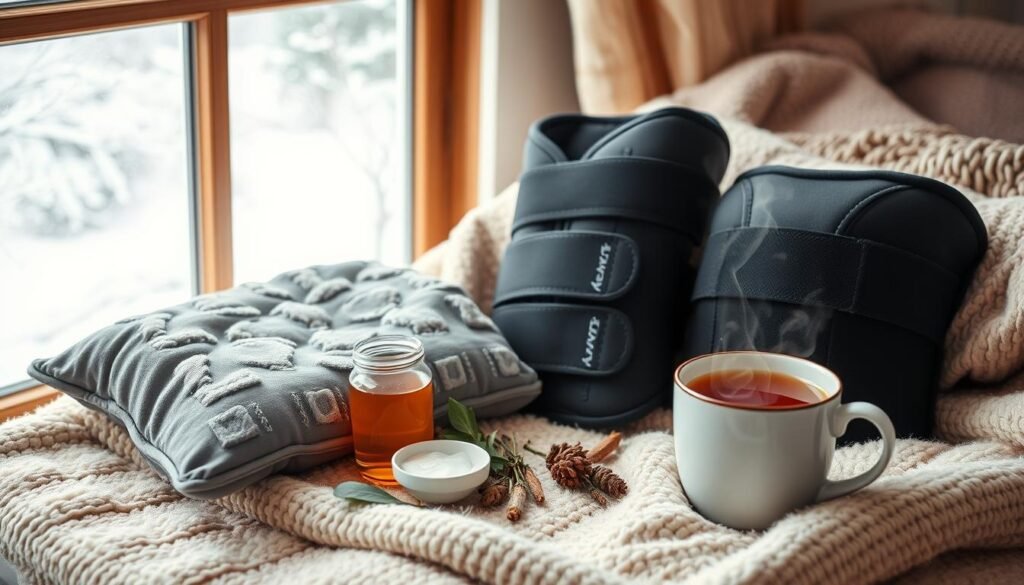
Natural Remedies and Self-Care Techniques
When it gets colder, many people feel more knee pain. Luckily, there are natural ways to feel better. Heat therapy and stretching can help a lot.
Heat Therapy Methods
Heat helps blood flow and makes knees feel better. Try warm baths, heating pads, or hot compresses. These simple steps can help with knee pain.
Supplements and Nutrition
Some supplements, like vitamin D, can help with knee pain. Vitamin D is important for pain levels. Eating foods that fight inflammation is also good for your joints.
Gentle Stretching Routines
Stretching every day keeps knees flexible and less painful. Focus on the muscles around your knee. Stretching helps with movement and stiffness.
Using these natural methods can help you manage knee pain in winter. Always talk to a doctor before trying new treatments. We can find ways to keep you moving comfortably.
“Stretching and muscle strengthening exercises are crucial for maintaining knee health, especially during the winter when joint discomfort can be exacerbated.”
When to Seek Professional Medical Help
If your winter joint pain stops you from doing daily things or hurts too much, see an orthopedic doctor. Professional medical help is needed if pain lasts and you see signs of serious inflammation or injury.
At your visit, the orthopedic doctor will ask about your health, check your joints, and might do tests like X-rays or MRIs. They’ll then make a plan to help with joint pain relief and managing symptoms.
- Winter’s cold can make joint fluid thicker, causing more friction and pain, especially in knees and hips.
- Being less active in winter can hurt your joints.
- Seeing a physical therapist can help with joint pain, improve movement, balance, and strength, and manage long-term joint issues.
- Physical therapists teach exercises to make sure you do them right and offer support.
If you have ongoing joint pain, trouble moving, stiffness, or keep getting hurt, get professional medical help. Think about physical therapy or an orthopedic examination.
“Seeing an orthopedic doctor can give you a plan for better joint health. They offer treatments for pain, inflammation, stiffness, and lack of mobility.”
Winter Sports Safety and Knee Protection
Winter sports fans need to protect their knees more in cold weather. The cold makes muscles and tendons less flexible. This increases the chance of knee injuries.
Doing warm-up exercises before playing is key. It gets the body ready for winter sports.
Thermal knee braces are a good idea. They support and warm the knees during activities like skiing. Being careful and choosing less intense sports can also help avoid knee injuries.
Using the right gear and knowing your limits are important. The American Academy of Orthopaedic Surgeons says sprains, strains, dislocations, and fractures are common. Many happen when people get tired or push too hard. Staying alert and following the rules can help keep knees safe.
- Warm up before playing winter sports.
- Use thermal knee braces for extra support.
- Be careful with high-impact sports and choose easier ones on cold days.
- Make sure your equipment fits right, including boots and protective gear.
- Learn the right techniques from experts to avoid knee injuries.
- Stop when you’re tired or in pain.
By following these steps, you can lower the risk of knee injuries. This way, you can keep enjoying winter sports while keeping your knees healthy.
| Winter Sport | Injury Rate | Common Knee Injuries |
|---|---|---|
| Skiing | 76,000 injuries in the U.S. in 2018 | Sprains, strains, dislocations |
| Snowboarding | 53,000 injuries in the U.S. in 2018 | Torn ligaments (ACL, MCL) |
| Ice Skating | 48,000 injuries in the U.S. in 2018 | Sprains, strains |
| Sledding/Tobogganing | 22,000 injuries in the U.S. in 2018 | Fractures, dislocations |
By focusing on safety, using protective gear, and knowing your limits, you can have fun in winter sports. This way, you can avoid knee injuries.
Conclusion
Managing knee pain in winter needs a full plan. We must know the causes, use good prevention, and get help when needed. Staying active, keeping a healthy weight, and using the right treatments help a lot.
The cold weather can make knee pain worse. But, with the right care, we can stay comfortable and move easily. Doing 30 minutes of exercise five days a week helps our knees and makes them feel better.
Knowing why winter hurts our joints helps us take action. We can use natural ways and see doctors for help. This way, we can keep our knees strong and enjoy winter more.
FAQ
What are the main reasons why knee pain gets worse in the winter?
Knee pain can worsen in winter due to several reasons. Changes in air pressure and thicker synovial fluid are key factors. These changes can make knees stiffer, more painful, and less mobile.
How do weather changes affect knee pain and joint health?
Weather changes can impact knee pain in complex ways. Cold weather makes knee tissues tighter, reducing flexibility. Also, air pressure changes can make tendons expand and contract, increasing pain.
What are the common triggers for winter joint discomfort?
Several factors can lead to joint stiffness and pain in winter. Temperature swings, humidity, and less physical activity are common culprits. The cold itself is a major contributor.
How does cold weather affect arthritis and overall joint health?
Cold weather can worsen pain in arthritic joints. The fluid in joints may become thicker, reducing its cushioning effect. Cold also makes inflamed joints more sensitive.
What are some effective prevention strategies for managing winter knee pain?
To prevent knee pain in winter, wear warm clothes and stay active. Indoor exercises like yoga or swimming are good options. Drinking water, maintaining a healthy weight, and getting enough sleep are also key.
What are some treatment options for cold weather joint pain?
Heat therapy can help by improving circulation and muscle relaxation. Anti-inflammatory drugs and turmeric capsules can also ease pain. Physical therapy strengthens muscles, improves flexibility, and teaches pain management.
When should someone seek professional medical help for winter knee pain?
If joint pain from winter weather hinders daily life or is severe, see an orthopedic doctor. Medical help is needed if pain doesn’t improve with self-care or if there’s severe inflammation or injury.
How can winter sports enthusiasts protect their knees?
To protect knees in winter sports, do proper warm-ups and use thermal knee braces. Be cautious in activities like skiing or snowboarding. Choose low-impact sports on very cold days and know your limits to avoid injuries.
